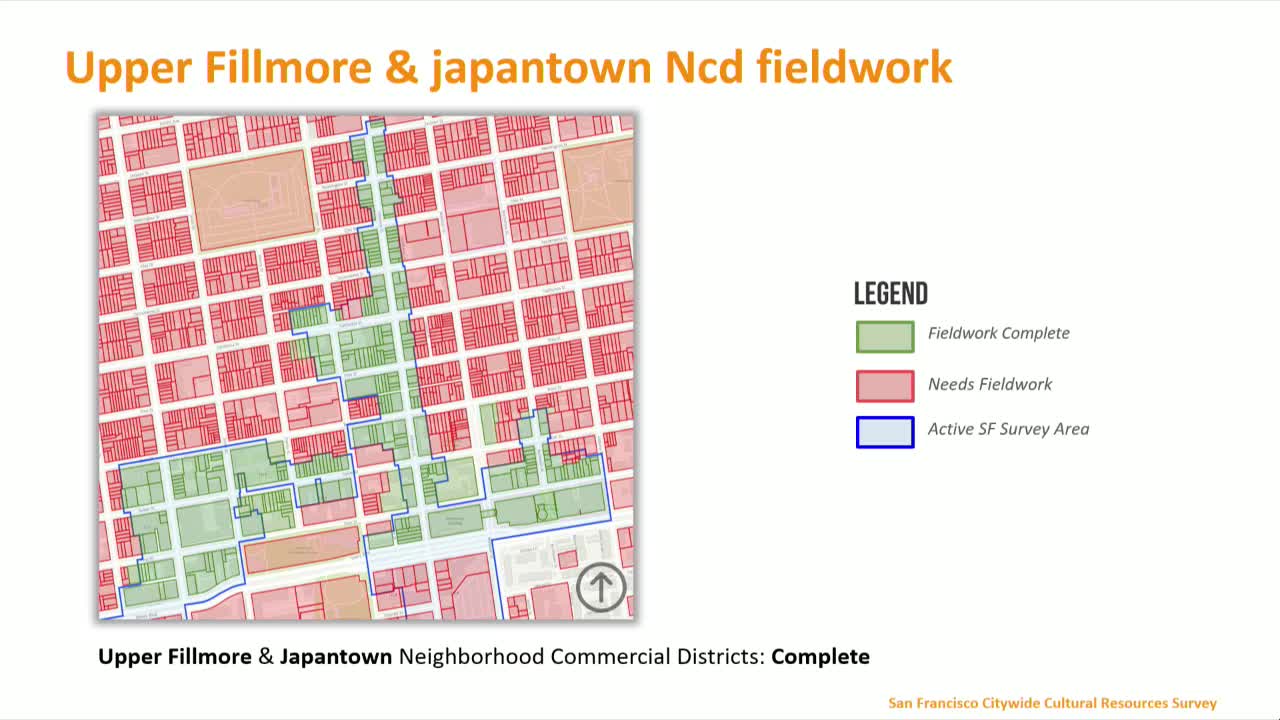San Francisco surveys historic properties in Upper Fillmore Neighborhood Commercial District
April 17, 2024 | San Francisco City, San Francisco County, California

This article was created by AI summarizing key points discussed. AI makes mistakes, so for full details and context, please refer to the video of the full meeting. Please report any errors so we can fix them. Report an error »

In the heart of San Francisco, city officials gathered to discuss the future of the Upper Fillmore Neighborhood Commercial District, a vibrant area steeped in cultural history. The meeting, held on July 4, 2025, showcased the city’s commitment to preserving its rich heritage while fostering community engagement.
Ashley, a department staff member, opened the session by highlighting the successful completion of initial fieldwork and research in the Upper Fillmore area. This district, stretching from Jackson Street to Bush Street along Fillmore, is not just a collection of buildings; it represents a tapestry of community stories and cultural significance. The department's engagement framework, developed in collaboration with community partner Erica Riebe of InCommon, aims to adapt and respond to the evolving needs of residents, ensuring that their voices are heard in the planning process.
The meeting emphasized the importance of community partnerships, showcasing a variety of engagement strategies designed to foster collaboration and inclusivity. These strategies include community briefings, workshops, and digital platforms, all aimed at enhancing social equity and cultural awareness. A notable tool introduced is the Community Input Dashboard, which aggregates feedback from various community interactions, allowing city staff to track concerns and interests effectively.
Melanie Bishop, another department staff member, took the floor to present the findings from the Upper Fillmore survey. Out of 96 properties evaluated, 61 were identified as historic resources, reflecting the area’s architectural and cultural significance. Among these, the historic Minnie's Can Do Club, once a jazz hub, stands as a testament to the African American cultural heritage that flourished in the Fillmore during the 20th century.
The meeting also revealed the establishment of the Upper Fillmore Neighborhood Commercial Historic District, which encompasses a range of architectural styles from the Victorian era to the Jazz Age. This district not only highlights the evolution of the area but also honors the contributions of the Japanese American and African American communities.
As the meeting concluded, city officials outlined their next steps, which include continued collaboration with community partners to address redevelopment concerns and further develop methodologies for recognizing intangible cultural heritage. The commitment to preserving the past while engaging the community in shaping the future was clear, leaving attendees with a sense of hope and anticipation for what lies ahead in the Upper Fillmore Neighborhood.
Ashley, a department staff member, opened the session by highlighting the successful completion of initial fieldwork and research in the Upper Fillmore area. This district, stretching from Jackson Street to Bush Street along Fillmore, is not just a collection of buildings; it represents a tapestry of community stories and cultural significance. The department's engagement framework, developed in collaboration with community partner Erica Riebe of InCommon, aims to adapt and respond to the evolving needs of residents, ensuring that their voices are heard in the planning process.
The meeting emphasized the importance of community partnerships, showcasing a variety of engagement strategies designed to foster collaboration and inclusivity. These strategies include community briefings, workshops, and digital platforms, all aimed at enhancing social equity and cultural awareness. A notable tool introduced is the Community Input Dashboard, which aggregates feedback from various community interactions, allowing city staff to track concerns and interests effectively.
Melanie Bishop, another department staff member, took the floor to present the findings from the Upper Fillmore survey. Out of 96 properties evaluated, 61 were identified as historic resources, reflecting the area’s architectural and cultural significance. Among these, the historic Minnie's Can Do Club, once a jazz hub, stands as a testament to the African American cultural heritage that flourished in the Fillmore during the 20th century.
The meeting also revealed the establishment of the Upper Fillmore Neighborhood Commercial Historic District, which encompasses a range of architectural styles from the Victorian era to the Jazz Age. This district not only highlights the evolution of the area but also honors the contributions of the Japanese American and African American communities.
As the meeting concluded, city officials outlined their next steps, which include continued collaboration with community partners to address redevelopment concerns and further develop methodologies for recognizing intangible cultural heritage. The commitment to preserving the past while engaging the community in shaping the future was clear, leaving attendees with a sense of hope and anticipation for what lies ahead in the Upper Fillmore Neighborhood.
View full meeting
This article is based on a recent meeting—watch the full video and explore the complete transcript for deeper insights into the discussion.
View full meeting
